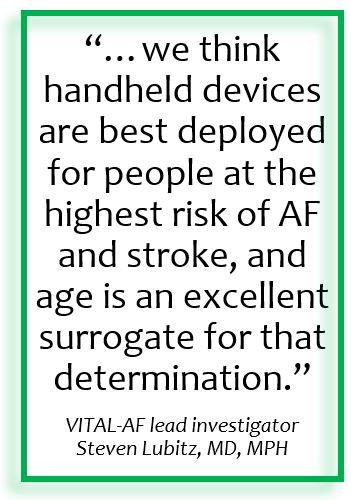- Clinical Technology
- Adult Immunization
- Hepatology
- Pediatric Immunization
- Screening
- Psychiatry
- Allergy
- Women's Health
- Cardiology
- Pediatrics
- Dermatology
- Endocrinology
- Pain Management
- Gastroenterology
- Infectious Disease
- Obesity Medicine
- Rheumatology
- Nephrology
- Neurology
- Pulmonology
Routine Point-of-Care Screening for Afib in Primary Care May Be Most Useful in Oldest Adults
Routine point-of-care AF screening in primary care using a handheld ECG device proved feasible but increased diagnoses only in patients aged ≥85 years, in the VITAL-AF study.
Routine mobile point-of-care screening for atrial fibrillation (AF) in primary care for patients aged ≥65 years did not significantly increase new diagnoses of the arrhythmia overall but did enhance detection by approximately 2% in those ≥85 years, according to findings of the VITAL-AF study published online March 2, 2022, in the journal Circulation.
VITAL-AF, conducted by investigators at the Massachusetts General Hospital (MGH), was designed to determine whether routine screening of older adults using a hand-held, single-lead ECG would be more effective for diagnosing AF when compared to usual care in a primary care setting.
“Our work affirmed that single-lead devices generate information for the physician that is actionable, though the proportion of newly detected AF cases using a point-of-care ECG screening approach is likely to be very small," said lead investigator Steven Lubitz, MD, MPH, a cardiologist, electrophysiologist, and physician investigator with the Cardiovascular Research Center at MGH, in a hospital press release. "For that reason, we think handheld devices are best deployed for people at the highest risk of AF and stroke, and age is an excellent surrogate for that determination.”

Morbidity and mortality associated with AF are largely driven by challenges to timely diagnosis and treatment. Clinical guidelines differ on recommendations for screening for AF, write Lubitz et al, and as mobile technologies are increasingly being used to detect AF in a variety of clinical and community settings, one of the many challenges is to determine viability and potential clinical yield of routine use.
VITAL-AF was conducted at 16 primary care clinics in the MGH Primary Care Practice Based Research Network and enrolled patients aged ≥65 years from July 31, 2018, to October 8, 2019. Clinics were randomized in 1:1 fashion to screen patients for AF using either a handheld single-lead ECG (AliveCor, KardiaMobile) or usual care procedures while assessing vital signs.
The primary outcome of interest for Lubitz and colleagues was new AF diagnoses during a 1-year screening period. Secondary outcomes included proportions and incidence rates during the same period.
Overall, there were 30 715 patients without prevalent AF enrolled in VITAL-AF. Approximately half (15 393) were screened for AF with the single-lead ECG device and the other half (15 322) screened using usual care.
All study patients had at least 1 eligible visit at 1 of the 16 study clinics during the screening period, resulting in 38 880 encounters among those screened with the single-lead ECG device and 40 450 encounters among those in the control group. Median patient-level follow-up was 279 days in the former group and 282 days in the latter. Patient characteristics in the 2 arms were well balanced, the authors write.
Potentially higher clinical yield in high-risk populations
Investigators report that among those screened using the handheld device, 1.72% had newly diagnosed AF at 1 year and of those screened via usual care,1.59% were diagnosed (risk difference [RD], 0.13% [95% CI, -0.16 to 0.42]; P=.38). Results of prespecified subgroup analyses showed that new AF diagnoses in both the handheld and usual care screening groups were greater among participants aged ≥85 years (5.56% vs 3.76%, respectively, RD 1.80%, 95% CI 0.18-3.30).
Lubitz et al also found that the difference in newly diagnosed AF between the screening period and the prior year was marginally greater in the handheld AF screening vs control group (0.32% vs -0.12%, respectively; RD, 0.43%, [95% CI -0.01 to 0.84]). They reported no difference between the single-lead ECG and control screening groups in the proportion of individuals newly diagnosed with AF who were initiated on oral anticoagulation therapy (73.5% vs 70.8%, respectively; RD, 2.7%; 95% CI -5.5 to 10.4).
The authors also report that during the 1-year study period, 91% of eligible patients were screened using the single-lead rhythm assessment, a demonstration of the feasibility of the technology in routine primary care practice. The point-of-care ECG simply requires a patient to place their fingers on the device for 30 seconds vs the 10-15 minutes typically required to use the standard ECG equipment in outpatient practice.
“Considering that advanced age is associated with a substantially increased risk of both AF and stroke, point-of-care screening might be an efficient use of single-lead, handheld electrocardiograms for adults 85 and over,” concluded Lubitz et al.
Reference: Lubitz SA, Atlas SJ, Ashburner JM, et al. Screening for atrial fibrillation in older adults at primary care visits: the VITAL-AF randomized controlled trial. Circulation. 2022. Published online ahead of print March 2, 2022.
